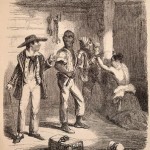About 2/3rds of the way through through Marcus Wood’s Blind Memory, I’m convinced that the imagery of Atlantic slavery is a very important aspect in the evolution of BDSM. There are many, many written and visual examples of slaves being beaten and otherwise tormented in abolitionist texts. Frequently, these images become an opportunity to depict the black female body nude or semi-nude in extremis.
Whereas racist and pro-slavery art caricatured blacks, male and female, as subhuman and repulsive, abolitionist art tried to humanize the blacks to encourage empathy to the suffering, but somehow things kept slipping over into the erotic. Female blacks were often depicted as lighter or even “white”, a limitation of printing technology of the time that couldn’t depict subtle variations in skin tone.
In Uncle Tom’s Cabin, the classic abolitionist text and the bestselling novel of the nineteenth century, there’s a minor character named Prue, an elderly, drunken, suicidal slave woman, frequently beaten and finally left in a cellar where flies got her. However, in the 1867 illustrated edition by Warde Locke and Co, “Prue is now a very shapely, young and topless woman whipped by a white gentleman in elegant clothing. In the foreground another man gazes on, clutching a pair of scissors in his right hand, with which he has just sliced off Prue’s clothing; the remainder of her dress appears about to slide off her hips. A grinning crowd enjoys the spectacle, and there is the appalling inference that we are meant to join them.” (Pg.185) I suspect that the man in Psychopathia Sexualis who described being aroused by Uncle Tom’s Cabin had an edition with such illustrations.
This is not Stowe’s fault. Her book was a massive cultural phenomenon on both sides of the Atlantic, with myriad authorized and unauthorized editions and, believe it or not, merchandising. (You could play the Uncle Tom’s Cabin card game or smoke Topsy tobacco.) When that happens, the original text, or even just the superficial symbols, can be used by multiple audiences for different purposes. Stowe’s original text had powerful moments depicting the horrors of slave society, yet it also had a lot of Victorian sentimental treacle and childish/feminized blacks who are only redeemed by Christianity.
And this sort of weird racial-sexual ambiguity is still going on today.

Why would a film based on an abolitionist text have a poster that looks more like a gay BDSM video? Interestingly, one of the 13 film versions listed at IMDB is a 1976 version released in the blaxploitation/softcore era that an IMDB user describes as “This film’s sole purpose is to show nude bondage. I’m not complaining, because the bodies of the men are awesome. Lots of slave men and women tied up, hanging by the wrists…totally naked and whipped.” (Ellipsis in original)
One of the curious things I’ve noticed is that there is no mention of Atlantic slavery or abolitionist literature in Ian Gibson’s The English Vice: Beating, Sex and Shame in Victorian England and After, and Edward Anthony’s The Rod and Staff also includes no imagery from the Atlantic slavery context, and only a footnote reference to Uncle Tom’s Cabin. Gibson’s book is very much an anti-school corporal punishment text, so he may not have considered the wider sources of flagellant imagery.
Wood’s theory is that Atlantic slavery is such a massive and horrible thing that it is hard to think about on both an individual and a cultural level, so we tend to think about in an indirect way, misdirecting our thoughts. Abolitionist literature, drawing on Christian martyrology and filtered through the cult of sensibility, is a major contribution to modern BDSM.



